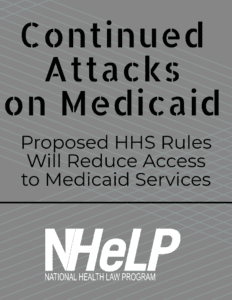 The U.S. Department of Health & Human Services (HHS) proposed changes to the Medicaid “equal access” rule that are intended to erode beneficiaries’ access to covered Medicaid services.
The U.S. Department of Health & Human Services (HHS) proposed changes to the Medicaid “equal access” rule that are intended to erode beneficiaries’ access to covered Medicaid services.
As background, state Medicaid programs must set payment rates to ensure provider participation such that Medicaid services are available at least as readily as they are for people who are not in Medicaid. (See 42 U.S.C. Sec. 1396a(a)(30)(A)). Over the years, beneficiaries and providers used this legal requirement, known as the “equal access provision,” to hold states accountable when they cut Medicaid provider payment rates, or allowed rates to stagnate such that access to covered Medicaid services was diminished. In 2015, however, the Supreme Court ruled in Armstrong v. Exceptional Child that providers could not enforce the equal access provision in federal court.
In response to Armstrong, HHS issued regulations on the equal access provision in late 2015. Its rule requires states to measure access to a specified set of Medicaid services for beneficiaries who receive services through a fee-for-service delivery system. States have to report their findings to HHS every three years, or whenever the state reduces rates that could cause diminished access. (See 42 C.F.R. Sec. 447.203(b)(6)(i)). National Health Law Programs ‘s comments on the final rule criticized HHS for declining to mandate that states measure access and rates for managed care delivery systems or waiver programs, since the statute does not distinguish these delivery systems or services.
The Trump administration has expressed skepticism about the scope of the final rule. In November 2017, it issued a letter to states, purporting to clarify that “nominal” rate reductions were unlikely to result in diminished access, and thus, states were not required to provide a comprehensive access report in those instances. The letter also suggested that HHS would allow states with a high level of managed care penetration in their Medicaid programs to engage in a less rigorous analysis of access. Now, HHS has proposed to revise the 2015 rules in two main ways: (1) exempt states from performing triannual access and monitoring reviews, or reviews of fee-for-service rate reductions if 85 percent or more of the state’s Medicaid beneficiaries received services through a comprehensive managed care arrangement; and (2) define rate reductions of 4 percent for one fiscal year, or up to 6 percent over two fiscal years, as nominal rate reductions unlikely to diminish access and not require states to perform comprehensive monitoring of these reductions or report to HHS.
The proposed changes will significantly weaken the rule, and as a result, are likely to exacerbate Medicaid access problems. Exempting states with high managed care penetration will lead to few states even reporting on access at all. As of July 2017, 17 states (including DC) have managed care penetration over 85 percent, exempting them from access monitoring and reporting requirements under the proposal. That number is likely to increase as more and more states move to managed care delivery systems. But beneficiaries in those states often still receive key services, such as mental health and substance use disorder services, on a fee-for-service basis as they are “carved out” from the Medicaid managed care system. Under the proposed rule, states will not have to regularly monitor or report on any difficulty accessing those services.
Further, exempting “nominal” cuts from monitoring and reporting fails to account for the cumulative effect of cuts over time, much less the effects of stagnant rates that fail to keep up with inflation and the marketplace. Under the proposed rule, states could cut rates 11 percent over four years without having to undergo any kind of rigorous monitoring or reporting. For example, in Illinois, the state’s failure to raise rates for pediatric in-home nursing services over many years led to severe shortages of nurses willing to provide services; under the proposed rule change, Illinois could cut rates 5 percent over two years without any scrutiny. The National Health Law Program opposes the proposed changes, and encourages other advocates to do so as well. Comments on the proposal are due May 22, 2018.

